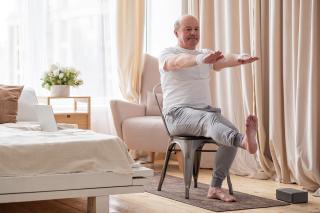As we age, maintaining strength and balance becomes essential—not just for mobility, but for safety and independence. Falls are the leading cause of injury among older adults, with 1 in 4 adults over 65 experiencing a fall each year, according to the CDC. These falls can lead to broken bones, reduced mobility, and a loss of confidence. But here’s the good news: many falls can be prevented.
We believe in helping you stay strong, steady, and independent for as long as possible. That starts with two important steps: building strength through low-impact exercise and making your home safer.
Why preventing falls matters
Falls aren't just accidents—they can have long-term consequences. From hip fractures to hospital stays, a single fall can limit your independence and affect your quality of life. Even if no serious injury occurs, the fear of falling again can cause you to move less, which in turn weakens muscles and increases fall risk.
The good news is that small daily actions—like light exercise and home adjustments—can make a big difference in preventing falls and protecting your health.
Simple exercises to build strength and balance
Staying physically active helps strengthen muscles, improve coordination, and keep your joints flexible—all of which reduce fall risk. The best part? You don’t need a gym membership or fancy equipment.
Try these low-impact exercises at home:
Chair stands
Great for strengthening legs and improving your ability to stand and sit safely.
- Sit on a sturdy chair with feet flat on the ground.
- Cross your arms over your chest.
- Slowly stand up, then sit back down.
- Repeat 5–10 times.
Heel-to-toe walking
Improves coordination and balance.
- Stand upright and place the heel of one foot directly in front of the toes of the other.
- Walk forward in a straight line for 10–20 steps.
- Use a wall or countertop for support if needed.
Side leg raises
Enhances hip and outer thigh strength.
- Stand behind a chair for support.
- Slowly lift one leg out to the side, keeping it straight.
- Lower the leg and repeat 10 times on each side.
Toe and heel raises
Builds ankle and calf strength to support stability.
- Stand with your hands on the back of a chair.
- Raise up onto your toes, hold for a second, then lower.
- Then rock back onto your heels, lifting your toes.
- Repeat 10–15 times.
Seated marching
Perfect if you prefer to stay seated while exercising.
- Sit upright in a sturdy chair.
- Lift one knee at a time as if marching.
- Repeat 10–20 times, alternating legs.
Always consult your doctor before beginning a new exercise routine. They can guide you on the safest and most effective movements for your health.
10 Easy ways to make your home safer
Falls often happen at home, where cluttered pathways, slippery floors, or poor lighting create hidden dangers. The good news? Many of these hazards are easy to fix. Here’s a list of simple, practical changes you can make to reduce your fall risk—one room at a time.
1. Clear the clutter
Remove any items that might cause tripping:
- Loose rugs, cords, and piles of magazines
- Shoes or bags in walkways
- Low furniture or floor-level decorations
Keep floors as clear as possible so you have safe, open walking paths in every room.
2. Install grab bars and handrails
Secure handrails and grab bars can provide essential support:
- Add grab bars near the toilet, bathtub, and shower
- Make sure stairs (indoors and out) have sturdy handrails on both sides
- Use a vertical bar next to your bed for extra help getting in and out
3. Improve lighting throughout the house
A well-lit home is a safer home.
- Use brighter bulbs in hallways and staircases
- Add nightlights in bathrooms, bedrooms, and along paths to the kitchen
- Keep a flashlight by your bed in case the power goes out
Try to reduce shadows and glare, which can make it harder to spot obstacles.
4. Secure or remove throw rugs
Rugs may be stylish, but they’re also a common tripping hazard.
- Remove loose rugs or use non-slip pads to keep them in place
- Choose rugs with low-pile and strong grip backings
- Avoid using rugs on stairs altogether
5. Use non-slip mats in the bathroom
Bathrooms are slippery by nature, so take extra care here.
- Add non-slip mats or adhesive strips inside the bathtub or shower
- Use a rubber-backed bathmat on the floor
- Consider a shower chair for stability while bathing
6. Reorganize to avoid reaching or bending
Keep everyday items within easy reach.
- Store dishes, clothing, and supplies at waist or chest level
- Avoid step stools or climbing on furniture
- Use long-handled tools for cleaning or grabbing items from high shelves
7. Wear supportive, non-slip footwear
The right shoes can prevent a misstep.
- Choose low-heeled, rubber-soled shoes that fit well
- Avoid walking in socks, slippers without grip, or shoes that easily slip off
- Replace worn-out soles regularly
8. Use assistive devices if needed
If your doctor recommends using a cane or walker, use it confidently.
- Have your device properly fitted to your height
- Don’t hold furniture or walls for support if a device would be safer
- Bring your assistive device with you around the house
9. Secure electrical cords
Cords running across the floor are an easy way to trip.
- Tape cords to the wall or baseboard
- Use cord organizers to keep them out of walkways
- Avoid using extension cords in high-traffic areas
10. Keep frequently used items together
Reduce the need to move around too much or rush.
- Store your phone, glasses, medications, and a flashlight in one accessible spot
- Use a basket or tray to keep these essentials close to your favorite chair or bedside
Talk to your doctor about fall prevention
Fall risk increases with certain health conditions and medications. You should speak to your doctor if you:
- Have fallen in the past year
- Feel unsteady while walking
- Take medications that cause dizziness or drowsiness
- Have vision issues
- Are limiting your movement out of fear of falling
We can help by:
- Reviewing your medications
- Recommending physical therapy or balance exercises
- Offering vision referrals
- Providing personalized fall prevention plans
Small steps lead to safe, independent living
Preventing falls doesn’t require major changes or expensive equipment. With simple daily exercises and thoughtful home adjustments, you can reduce your risk and gain peace of mind. And most importantly, you can continue doing the things you love—on your own terms.
We’re committed to helping you stay strong, steady, and supported. If you’re concerned about balance, strength, or fall risk, talk to your care team. Together, we’ll create a plan that protects your health and keeps you confidently on your feet.
If you aren’t already a patient, we’d love to meet you and get you on track to feeling your best. Click here to find a center near you and take a tour with us!




